The basics of Commercial HVAC design are key to making systems work well in commercial areas. Choosing the right system means it meets the space’s heating and cooling needs. This depends on size, how many people use it, and how well it’s insulated.
Using HVAC system design tips to save energy can cut down on costs. Following the rules is not just a must; it also helps use energy-efficient HVAC solutions. The latest Guide B by CIBSE offers detailed advice on designing HVAC systems.
Key Takeaways
- Accurate load calculations are crucial for efficient HVAC design.
- Proper system sizing prevents discomfort and energy wastage.
- Zoning enhances comfort by allowing independent temperature controls.
- Well-designed ductwork ensures even air distribution.
- Energy-efficient systems align with sustainability goals while reducing costs.
Introduction to Commercial HVAC Systems
Commercial HVAC systems are key to keeping spaces comfortable and healthy. They control temperature, humidity, and air quality. They are often bigger and more complex than home systems.
The goal is to keep the temperature around 72 degrees Fahrenheit. Humidity should be between 40% and 60%.
These systems use heating units like boilers and furnaces. They use natural gas, oil, or electricity to heat the air. This air is then spread through ductwork or radiators to keep the space warm.
Ventilation systems are vital for clean air. They can be natural or mechanical. They have filters that remove pollutants and allergens, keeping CO2 levels low.
Air conditioning units cool the space. They include central air conditioners and split systems. These units have parts like condensers and evaporators that lower the temperature.
Some HVAC systems, like VRF systems, are up to 30% more energy-efficient. They save energy and reduce greenhouse gas emissions.
Commercial HVAC systems come in different types. Each is suited for different building sizes and needs. Common types include:
- Split systems: Versatile and suitable for a range of building sizes, though they do not provide direct ventilation.
- Packaged systems: Combine all components in one unit, often including ventilation, making them ideal for smaller buildings.
- VAV (Variable Air Volume) systems: Diverse systems providing heating, cooling, and ventilation to medium and large commercial buildings.
Choosing the right commercial HVAC system is important. It depends on heating units, cooling needs, efficiency, and building layout. Proper planning and design lead to better performance, energy savings, and lower maintenance costs.
| Factors | Considerations |
|---|---|
| Heating Units | Boilers, Furnaces, Heat Pumps, Electric Heaters |
| Cooling Systems | Central Air Conditioners, Split Systems, Packaged Systems |
| Ventilation | Natural, Mechanical (with filtration) |
| Energy Efficiency | Standard vs. High-Efficiency VRF Systems |
| System Layout | Building Size, Zoning Needs |
Types of HVAC Systems for Commercial Buildings
Choosing the right HVAC system is key for comfort and efficiency in commercial buildings. Different systems fit various space sizes and needs. Here are some common commercial HVAC types:
Single-split HVAC systems work well for smaller buildings and server rooms. They are easy to install and cost-effective for single-room needs.
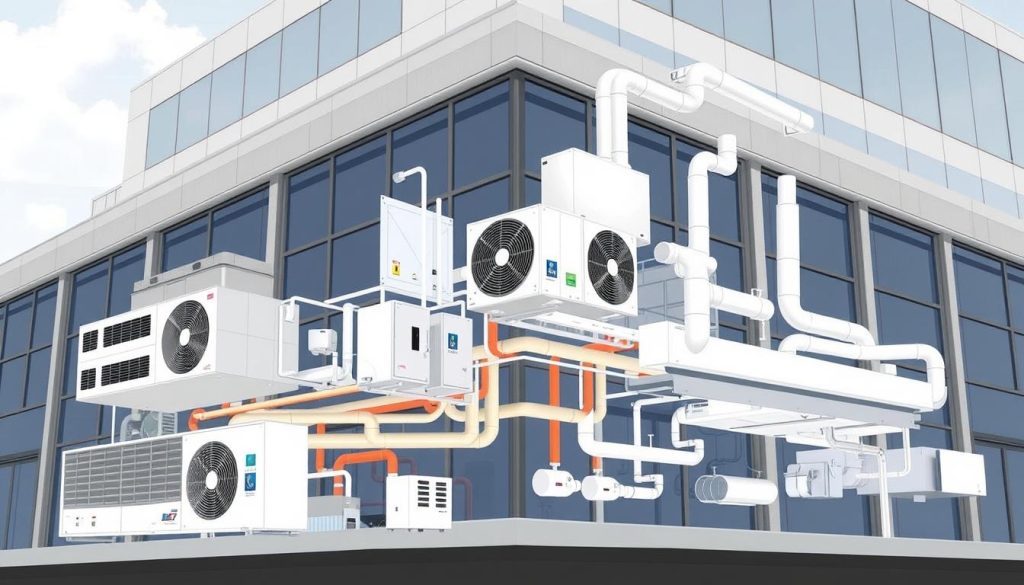
For large properties, multi-split systems are best. They connect multiple indoor units to one outdoor unit. This setup offers flexibility in temperature control across different rooms.
VAV systems are great for small offices. They adjust airflow based on room needs, saving energy without sacrificing comfort.
VRF systems are versatile for various commercial spaces, including mixed-use facilities. They are efficient, flexible, and use eco-friendly refrigerants.
CAV systems are ideal for large open areas like exhibition halls. They maintain a constant airflow rate while adjusting the air temperature for steady climate control.
Heat pump systems are good for schools and sports facilities. But, they’re not for very cold climates since their efficiency drops below 40 degrees Fahrenheit.
Commercial buildings often need HVAC systems with capacities up to hundreds of tons. The five most common commercial HVAC types for these buildings are Chillers, District Cooling, VRV or VRF systems, RTU (Rooftop Units), and Direct Expansion systems.
| HVAC System | Use Case | Key Features |
|---|---|---|
| Chillers | Larger office buildings | Require extensive infrastructure like chillers, pumps, pipes, and cooling towers |
| District Cooling | Large developments | Allows buildings to purchase chilled water from central plants |
| VRV/VRF Systems | Mixed-use facilities | Flexible, efficient, and use low global warming potential refrigerants |
| Rooftop Units (RTUs) | Low-rise commercial buildings | Self-contained systems with a lifespan of 15 to 20 years |
| Direct Expansion (DX) Systems | Small commercial buildings | Resemble oversized residential A/C units |
Using HVAC design best practices ensures the chosen system meets energy and ventilation needs. Regular maintenance, like daily or weekly checks, helps spot problems early. This keeps the environment healthy and productive for everyone.
Single Split Systems
Single split systems are great for small commercial areas like offices, shops, and server rooms. They keep one room or zone at the right temperature. Each system has one indoor unit and one outdoor unit connected by refrigerant lines.
These systems are affordable and simple. They’re perfect for small businesses. Unlike multi-split systems, they don’t need complex setups. This makes them cheaper to install.
HVAC design software is key for designing single split systems. It helps figure out the right size and placement. This ensures the system works well and efficiently.
The software also lets designers tailor the installation for small spaces. This customization boosts the system’s performance. It keeps the climate in each zone consistent and reliable.
However, single split systems have their limits. They might not work for big buildings because they need many units. This can be expensive and take up a lot of space. So, it’s important to think about other options like multi-split or VRF systems for bigger areas.
In summary, single split systems are a good choice for small commercial spaces. They offer control over each room, are affordable, and easy to set up. Using HVAC design software can make these systems even better. It ensures they meet the specific needs of the businesses they serve.
Multi-Split Systems
A multi-split HVAC system is great for big commercial spaces. It lets you control each room’s temperature without many outdoor units. These systems are efficient and can grow with your needs.
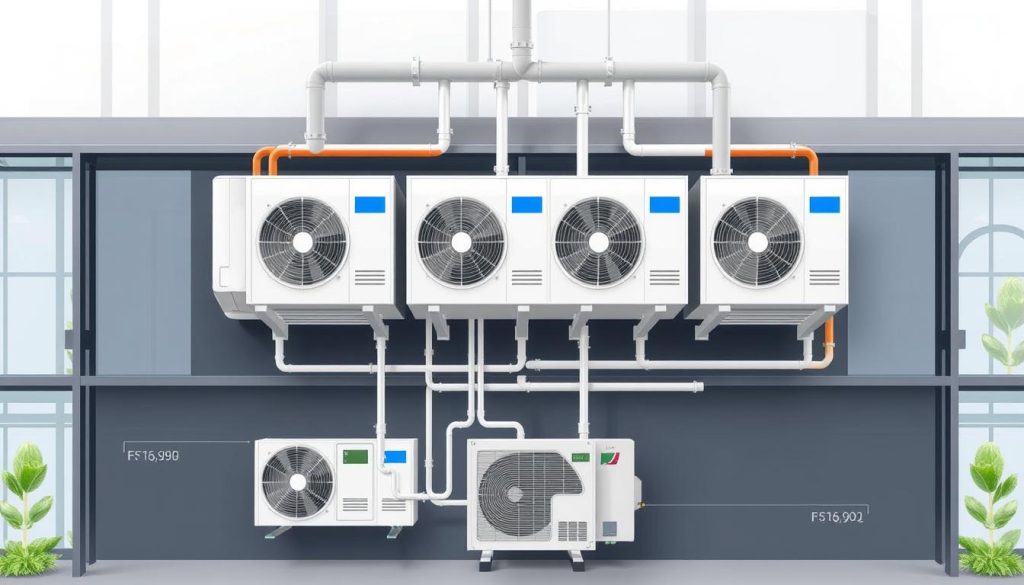
These systems are perfect for saving space and improving function. They let you set different temperatures in each room. This is great for offices, stores, and hospitals. It makes everyone more comfortable and saves energy by adjusting to each room’s needs.
When you get a multi-split HVAC system, you need to do HVAC design calculations right. This ensures your system works well and saves energy. You must figure out the right size for your system, considering each room’s needs and the outdoor unit’s power.
Multi-split systems also look better with fewer outdoor units. They spread air better and are quieter than single systems. This makes them a smart choice for your building.
For your commercial HVAC needs, talk to experts like Comfort Systems of Montana. They know a lot about multi-split systems. They can help you get the best comfort, efficiency, and look for your space.
Packaged Rooftop Units (RTUs)
Packaged rooftop units (RTUs) are key parts of commercial HVAC systems. They have all the parts needed for heating and cooling in one box. These units are great for single-storey buildings because they are installed on rooftops.
RTUs cool about 60% of commercial spaces in the U.S., says the U.S. Department of Energy. They connect to ductwork to move air and keep temperatures steady. This setup helps control airflow and temperature well.
RTUs come in different types, like those that only use fresh air or have filters. They also have heating and cooling coils. These parts help control air temperature.
RTUs are loved in the commercial HVAC world for being compact and weatherproof. They use single coils and fans to move air. This makes them efficient for heating and cooling.
RTUs are built to last and handle weather well because they’re on rooftops. They’re also space-saving. Some RTUs, like makeup air units, need extra insulation and energy.
The International Mechanical Code says RTUs need a level platform on each side for roofs with a 25% slope or more. This makes sure RTUs are installed safely and work well.
RTUs are a good choice because they’re efficient and cost-effective. But, they can’t be customized like semi-custom or custom units. Syska Hennessy chose semi-custom units for a hospital project because of specific air quality needs.
| Feature | Description |
|---|---|
| Components | Compressor, Condenser, Evaporator, Expansion Device |
| Installation | Rooftop, connects to ductwork |
| Applications | Commercial buildings, retail spaces, industrial properties |
| Efficiency | ASHRAE Standard 90.1 guidelines |
| Special Features | Dedicated outdoor air units, Free cooling cycle, Heat wheel integration |
Designing HVAC Systems for Commercial Buildings
Designing HVAC systems for commercial buildings is complex. It’s important to understand the needs of different zones and spaces. Using HVAC system design tips ensures each area has the right temperature and air quality.
First, think about your commercial building’s size. Getting the size right is key; too big or too small can waste energy and money. Tools like HVAC load calculations help find the perfect size for your system.
The layout of your building also matters. Spaces like conference rooms and kitchens need more cooling than areas like corridors or storage. So, each zone needs a custom approach.
Also, look at the specific zone requirements carefully. Consider things like how many people will be there, the amount of heat-generating equipment, and how comfortable you want it to be. For example, open-plan offices might need systems that adjust airflow based on how many people are there.
Energy efficiency is also crucial. High-performance HVAC systems save energy and money. Using systems like ground-source heat pumps or Dedicated Outdoor Air Systems (DOAS) can cut energy costs a lot. The U.S. Department of Energy says HVAC systems use 39% of energy in commercial buildings. Making your system more efficient can greatly reduce this.
Getting advice from professional organizations is very helpful. They make sure you follow the latest standards and best practices in designing commercial HVAC systems. For example, the American Society of Heating, Refrigerating and Air-Conditioning Engineers (ASHRAE) has guidelines for all kinds of buildings.
Here’s a table with some key points:
| Concept | Details | Benefits |
|---|---|---|
| Proper System Sizing | Using load calculations to determine optimal size | Enhanced efficiency, lower costs |
| Variable Air Volume (VAV) | Adjusting airflow based on occupancy | Consistent comfort, energy savings |
| High-Performance Systems | Integration of DOAS, ground-source heat pumps | Reduced energy consumption |
| Professional Guidelines | Utilizing ASHRAE and DOE resources | Compliance and up-to-date practices |
In conclusion, careful planning is key for HVAC system design in commercial buildings. Consider the building size, layout, specific needs of each zone, and energy efficiency. Using guidelines from trusted organizations can make your designs better and more compliant.
Commercial HVAC Design Guide
When looking at your commercial HVAC system, it’s key to know the building’s size, layout, and how many people will be there. This helps pick the right HVAC system for efficiency and comfort.
Energy efficiency is very important in commercial HVAC design. Using energy-saving parts like variable speed fans and SEER-rated units cuts down on costs. Also, getting it installed right by HVAC experts can save a lot of money later.
An HVAC system that’s too big might seem good, but it’s not. It leads to more starts and stops, making it hard to control temperature and humidity. Getting the right size and having it tuned by pros like Service Unlimited, Inc., makes it more efficient and lowers bills.
Regular maintenance is key to keeping your HVAC systems running well. It boosts energy efficiency and prevents costly repairs. Also, using the right air filters and keeping air ducts clean is important for good air quality and less allergens.
HVAC zoning systems are great for saving energy. They let you control comfort in different areas of your building. This can save a lot of money by using less energy where it’s needed most.
Other advanced systems like VRF and chilled beam systems also offer better control and energy use. VRF is good for big buildings with changing needs, while chilled beam systems work well in open offices and high ceilings.
When planning your HVAC, think about the building’s layout, how many people will be there, temperature changes, and if the system fits. This ensures your system works well and meets comfort needs everywhere.
Following industry standards is also vital. ASHRAE’s global guidelines help with energy efficiency in commercial buildings. ASHRAE Standard 90.1, set by the U.S. Department of Energy, is key for meeting rules and high energy performance.
In short, investing in top-notch HVAC design, regular upkeep, and following standards leads to a reliable and efficient system. This approach improves comfort, air quality, and saves money for your commercial space.
Energy Efficiency and Environmental Impact
It’s key to understand how HVAC systems save energy and help the planet. In offices, HVAC systems use a lot of energy, especially for heating and cooling. Choosing energy-saving HVAC can cut costs and reduce harmful emissions.
Smart thermostats have changed how we manage energy. They let us adjust settings in real-time to use less energy. This is based on the weather outside.
Using renewable energy sources makes HVAC systems more sustainable. Solar panels can power HVAC systems, cutting down on fossil fuel use. Geothermal systems use underground temperatures to control indoor climate with little harm to the environment.
Wind turbines and small hydropower are other green energy options. They help buildings use less fossil fuel, making operations greener.
Keeping HVAC systems in good shape is vital. Regular checks prevent energy waste and improve air quality. New technologies like variable speed motors and eco-friendly refrigerants save energy and reduce emissions.
Following rules and using advanced controls ensures HVAC systems are safe and efficient. This makes commercial buildings more sustainable for the future.
FAQ
Q: What are the essentials of designing a Commercial HVAC system?
Q: What are the common types of heating units used in commercial HVAC systems?
Q: How do ventilation systems contribute to indoor air quality?
Q: What are the key components of air conditioning units in commercial buildings?
Q: Can you explain the differences between single-split and multi-split HVAC systems?
Q: What are the advantages of using packaged rooftop units (RTUs) in commercial buildings?
Q: What considerations should be taken into account when designing an HVAC system for a commercial building?
Q: How does assessing building needs influence the selection of an HVAC system?
Q: What role does energy efficiency play in commercial HVAC design?
Q: What advancements and regulations support energy conservation in HVAC systems?
Source Links
- https://msheng.ca/top-5-essentials-in-commercial-hvac-design/
- https://www.cibsejournal.com/technical/guide-b-essentials-air-conditioning-and-refrigeration/
- https://www.supertechhvac.com/commercial-hvac-systems/
- https://cove.tools/blog/load-modeling-tool-guide-commercial-hvac-system-selection
- https://www.irbishvac.com/blog/2022/june/the-complete-guide-to-commercial-hvac/
- https://www.unitedmech.com/blog/types-of-hvac-systems-for-commercial-buildings
- https://aquilacommercial.com/learning-center/what-are-the-different-hvac-systems-for-commercial-buildings/
- https://lghomecomfort.ca/guides/ultimate-guide-to-commercial-hvac-systems/
- https://avmgroup.com/ultimate-hvac-guide/
- https://comfortsystemsofmt.com/blog/hvac-for-commercial-buildings-a-guide-to-hvac-systems-for-large-commercial-buildings/
- https://edisonparker.com/blog/commercial-hvac-systems
- https://www.csemag.com/articles/design-of-rtus-best-practices/
- https://www.buildingengines.com/blog/equipment-packaged-rooftop-unit-rtu/
- https://theengineeringmindset.com/rtu-rooftop-units-explained/
- https://www.mpofcinci.com/blog/basics-of-commercial-hvac-design-10-great-resources/
- https://www.wbdg.org/resources/high-performance-hvac
- https://www.ashrae.org/technical-resources/bookstore/ashrae-design-guides
- https://www.suihvac.com/hvac-design-guide-what-you-need-to-know/
- https://www.arzelzoning.com/guide-to-commercial-hvac-solutions/
- https://www.mpofcinci.com/blog/complete-guide-to-ashrae-standards-for-commercial-hvac-manufacturers/
- https://galgonhvac.com/hvac-environmental-impact/
- https://jamescraftson.com/blog/commercial-hvac-designs-and-maintenance/how-to-design-an-hvac-system-for-a-commercial-building/

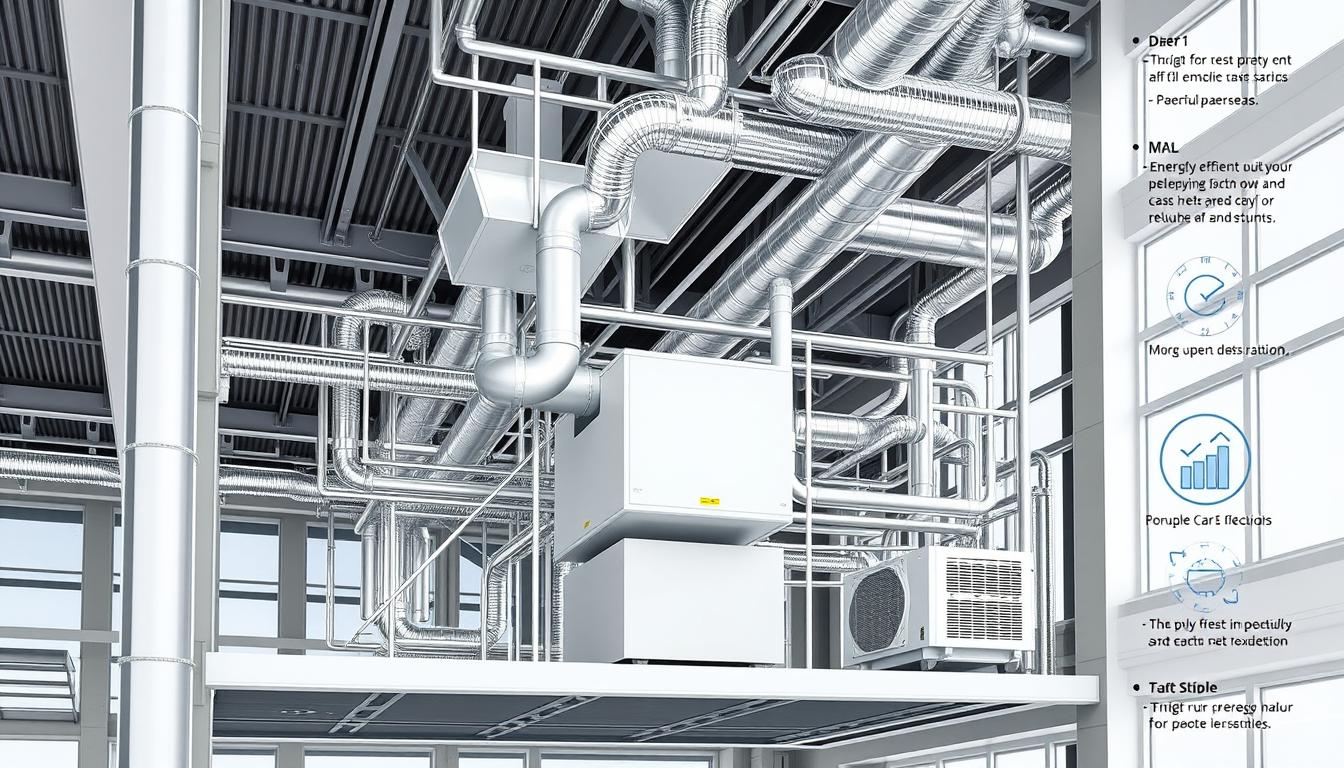

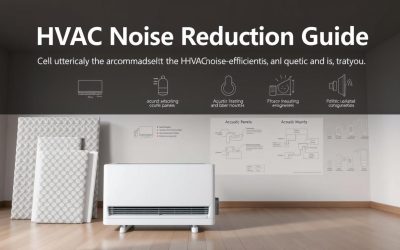
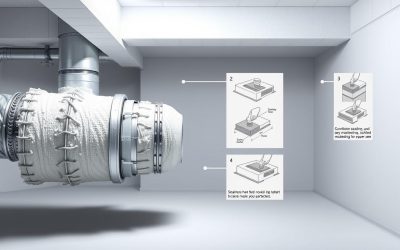
0 Comments